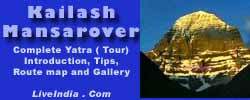| Ganga
source Alaknanda drying up?
NAINITAL: What price electricity?
Alaknanda, the majestic glacial river from the high Himalayas that gives
Bhagirathi its immense volume and turns it into the Ganga, is drying up
in large swathes (from six to 26 km) even before it meets the Bhagirathi
at Devprayag, raising deep concerns about the future of India’s holiest
river.
Alaknanda, which once
sliced through the Lambagar area just below the 400 mw Vishnu Prayag hydroelectric
power project in Chamoli, doesn’t flow there any more. Reason: heavy construction
work for a hydroelectric project has forced it to change its course. Environmentalists
warn that a delicate ecological balance in the area has been gravely imperilled
and say that up to 26 km of riverbeds along the Alaknanda and Bhagirathi
have begun to dry up.
In the case of Alaknanda,
the tragedy unfolded soon after the Uttarakhand government cleared the
construction of a 12-km-long tunnel and a four-storeyed hydro-electric
project in Chamoli about two years ago. Apparently, the explosives used
to build the project in the nearby river area and the debris of the construction
material played a major role drying up of the riverbed. ‘‘This is killing
the flora and fauna of the region,’’ says Dehradun-based senior scientist
N Ravi Chopra, who conducted a detailed research on the major causes of
the drying up of Alaknanda and Bhagirathi riverbeds.
The story at Maneri Bhali
village in Uttarkashi district, which Chopra has identified as seriously
damaged and dry area, is no different. The fate of its 10-km stretch along
the Bhagirathi riverbed was sealed by large quantities of debris of construction
material for constructing a power-house and other buildings for another
400-mw project.
‘‘These dry stretches
run for at least 20km from the construction site. The river thereafter
begins to revive when other streams and rivulets join it,’’ said Chopra.
For a government eager to undertake development work in rural areas, the
revival of rivers doesn’t seem to be the top priority. The director of
state disaster management cell Piyush Rautela said: ‘‘We are concerned
about the damage to riverbeds. We’ll have to find a middle ground where
development and river protection could coexist.’’
‘‘It will be our utmost
effort to maintain a balance between development and ensure that it doesn’t
affect our rivers,’’ said chief minister Bhuvan Chandra Khanduri at a press
conference here last week. All that can be said is the efforts should have
begun two years ago when the hydel projects began. From now on it will
be an uphill job trying to save the Alaknanda.
A recent study conducted
by the Central Inland Fisheries Research Institute on the Ganga has revealed
that due to increase in water temperature and erratic rainfall, some inland
fishes which breed mainly in the middle course of River Ganga are now coming
to the upper course of the river for breeding.
The study titled ‘Assessing
the impact of climate change on inland fisheries in river Ganga and its
plains in India’ revealed that the minimum and maximum temperature throughout
West Bengal has increased from 0.1 to 0.9 degrees Celsius in the last 40
years and as a result some of the carp fishes like Rohu (Labeo rohita),
Katla (Catla catla) and Mrigal (Cirhinus mrigala) have changed their place
of breeding. Mr Manas Kumar Das, a scientist of the institute, said usually
carp fishes breed in the months of June and July, but, as a result of the
rise in water temperature and low rainfall during the monsoon period, for
the past few years they have been breeding in the months of February and
March. Moreover, the breeding period has also extended from 60 days to
110 -120 days during this period. Between 1996-2005, the average annual
rainfall in West Bengal has decreased, but the amount of rainfall during
the month of September -October has increased.
Experts feel that for
fishes to breed in a congenial environment there is a need for adequate
rainfall and since they are not getting that in the middle and lower course
of the river, they are shifting their geographical position. As a result
there has been a decline in fish production in areas falling under the
middle and lower course of the river Ganga.
This has adversely affected
the livelihood of fishermen residing in these areas. They also claimed
that the state will experience a 3.5 to 4.5 degree average increase in
temperature by the year 2080 and that a holistic approach is needed to
minimise the effects of global warming. |

















